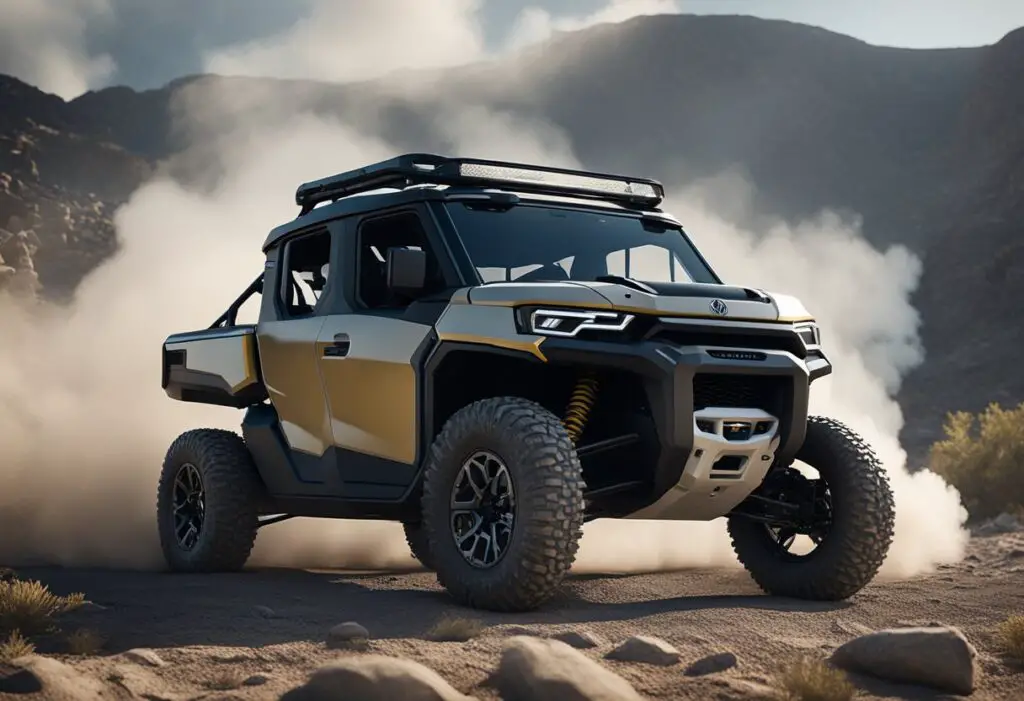Can-Am Defender is a popular ATV that is known for its powerful performance and durability. However, like any other vehicle, it can experience problems, one of which is a loss of power. This issue can be frustrating and worrying for owners, but it is important to understand the potential causes and how to address them.

Loss of power in a Can-Am Defender can be caused by various factors, including a clogged air filter, a faulty spark plug, or a dirty fuel injector. These issues can affect the engine’s performance and result in reduced power output. Additionally, problems with the transmission or clutch can also cause power loss.
If you are experiencing a loss of power in your Can-Am Defender, it is important to address the issue promptly. Ignoring the problem can lead to further damage and potentially costly repairs. By identifying the potential causes and taking the necessary steps to address them, you can ensure that your ATV is running smoothly and performing at its best.
Can-Am Defender Loss of Power: Common Causes
Power loss in Can-Am Defender can occur due to various reasons, which can be broadly classified into four categories: fuel system issues, air intake and filtration problems, ignition system failures, and exhaust and emission control problems. Each of these categories can have multiple causes, which can lead to a decrease in engine power.
Fuel System Issues
Fuel system issues are one of the most common causes of power loss in Can-Am Defender. A clogged fuel filter can restrict the flow of fuel to the engine, leading to a decrease in engine power. Similarly, a failing fuel pump can also result in power loss, as it cannot provide enough fuel to the engine. Low fuel pressure can also lead to a drop in engine power.
Air Intake and Filtration
Air intake and filtration problems can also cause power loss in Can-Am Defenders. A dirty or clogged air filter can restrict the flow of air to the engine, leading to a decrease in engine power. This can also result in a rich air-fuel mixture, which can cause the engine to run poorly. Similarly, a leak in the air intake system can also lead to a decrease in engine power.
Ignition System Failures
Ignition system failures can cause power loss in Can-Am Defender as well. A faulty spark plug or spark plugs can lead to misfires, which can cause a decrease in engine power. Similarly, faulty injectors can also result in misfires, leading to a decrease in engine power. An incorrect air-fuel ratio can also cause ignition system failures, leading to a decrease in engine power.
Exhaust and Emission Control
Exhaust and emission control problems can also cause power loss in Can-Am Defender. A clogged catalytic converter can restrict the flow of exhaust gases, leading to a decrease in engine power. Similarly, a malfunctioning oxygen sensor can cause the engine to run poorly, leading to a decrease in engine power. A leak in the exhaust system can also lead to a decrease in engine power.
In conclusion, power loss in Can-Am Defender can have various causes, as mentioned above. It is essential to diagnose the exact cause of power loss to ensure that the engine runs smoothly and efficiently. Regular maintenance and inspection of the fuel system, air intake and filtration system, ignition system, and exhaust system can help prevent power loss and ensure optimal engine performance.
Electrical and Electronic Concerns
Loss of power in a Can-Am Defender can be caused by a variety of electrical and electronic issues. These can range from problems with the battery and charging system to issues with the engine control unit (ECU), sensors, and wiring.
Battery and Charging System
The battery and charging system are critical components of any vehicle’s electrical system, and the Can-Am Defender is no exception. If the battery is not charging properly or is not providing enough power to the vehicle’s electrical system, it can cause a loss of power.
One common cause of battery and charging system problems is a faulty alternator. The alternator is responsible for charging the battery and providing power to the vehicle’s electrical system. If the alternator is not working properly, it can cause the battery to drain and the vehicle to lose power.
Engine Control Unit (ECU)
The engine control unit (ECU) is the brain of the vehicle’s engine management system. It controls the fuel injection, ignition timing, and other critical engine functions. If the ECU is not working properly, it can cause a loss of power.
One common cause of ECU problems is a faulty sensor. The ECU relies on sensors to monitor various engine parameters, such as rpms and engine load. If a sensor is not working properly, it can cause the ECU to make incorrect decisions, which can result in a loss of power.
Sensors and Wiring
The sensors and wiring in a vehicle’s electrical system are responsible for transmitting information to the ECU and other critical components. If the wiring is damaged or the sensors are not working properly, it can cause a loss of power.
One common cause of wiring and sensor problems is a damaged or corroded connector. Over time, the connectors in a vehicle’s electrical system can become damaged or corroded, which can cause a loss of power. It is important to inspect the connectors and wiring regularly to ensure that they are in good condition.
Mechanical and Cooling System Problems

Loss of power in Can-Am Defender vehicles can be caused by a variety of mechanical and cooling system problems. Here are some of the most common issues that can result in loss of power.
Engine and Cylinder Issues
Engine and cylinder issues can result in a loss of power in Can-Am Defender vehicles. Fouled spark plugs, clogged air filters, and leaky exhausts are some of the most common issues that can lead to engine problems. If the engine is not running smoothly, it can cause a loss of power.
Overheating and Radiator Malfunction
When the radiator becomes clogged, it restricts airflow and prevents proper cooling of the engine, leading to overheating. Overheating can cause severe engine damage and result in a loss of power. Coolant leaks, a faulty water pump, or a broken fan can also cause overheating.
Drive Belt and Clutches
Drive belt and clutch problems can cause a loss of power in Can-Am Defender vehicles. Belt slippage can cause the engine to lose power, and worn clutches can also cause a loss of power. It is important to regularly inspect the drive belt and clutches to ensure they are functioning properly.
Regular maintenance and inspection can help prevent mechanical and cooling system problems that can cause a loss of power in Can-Am Defender vehicles. If any of these issues are suspected, it is important to address them promptly to prevent further damage to the vehicle.
Troubleshooting and Maintenance Strategies

To diagnose and fix loss of power issues with Can-Am Defender, it is important to follow some troubleshooting and maintenance strategies. Here are some steps to take:
- Regular Maintenance: Regular maintenance is crucial for the proper functioning of any vehicle. It includes checking the engine, cooling system, steering, gears, belts, and clutch. Keep an eye on the electrical and fuel systems to avoid malfunctions that may disrupt the performance of your Can-Am Defender.
- Check the Air Filter: A clogged air filter can cause a loss of power in your Can-Am Defender. It restricts the flow of air to the engine, which can lead to poor performance. Make sure to clean or replace the air filter regularly.
- Inspect the Fuel System: A lack of proper fuel delivery can also sap engine power. Check the fuel pump, fuel lines, and fuel filter for any clogs or leaks. If you find any issues, replace the parts as necessary.
- Check the Spark Plugs: Fouled spark plugs can also cause a loss of power. Check the spark plugs and replace them if they are dirty or worn out.
- Tune the Engine: Tuning the engine can improve its performance and increase power. You can use BUDS (BRP Utility and Diagnostic Software) or OEM (Original Equipment Manufacturer) software to tune your Can-Am Defender.
- Clutch Work: Clutch work can also help to increase power. You can upgrade your clutch to a better one or adjust it to improve performance.
By following these strategies, you can diagnose and fix loss of power issues with your Can-Am Defender. However, if you are still experiencing issues, it may be a good idea to consult a professional mechanic or take your vehicle to a Can-Am dealer for further diagnosis and repair.
Frequently Asked Questions

What are common causes for power loss in Can-Am Defenders?
There are several common causes of power loss in Can-Am Defenders, including fouled spark plugs, clogged air filters, leaky exhausts, lack of proper fuel delivery, and blocked radiators. These issues can cause engines to overheat, potentially causing severe engine damage.
How does engine braking affect power in Can-Am Defenders?
Engine braking can cause a reduction in power output in Can-Am Defenders. This is because the engine is working against the transmission to slow the vehicle down, which can cause the engine to lose power.
What maintenance should be performed to prevent loss of power in Can-Am Defenders?
Regular maintenance is essential to prevent power loss in Can-Am Defenders. This includes changing the engine oil and filter, checking and replacing spark plugs, cleaning or replacing air filters, and inspecting the exhaust system for leaks.
How can power output be increased in a Can-Am Defender?
Power output can be increased in a Can-Am Defender by installing an aftermarket exhaust system, upgrading the air intake system, and installing a performance tuner. These upgrades can help to increase horsepower and torque, resulting in improved acceleration and top speed.
What are signs of excessive wear or high mileage in Can-Am Defenders?
Signs of excessive wear or high mileage in Can-Am Defenders include engine knocking or pinging, reduced power output, poor fuel economy, and increased exhaust emissions. These issues may be caused by worn out or damaged engine components, and should be addressed immediately to prevent further damage.
What troubleshooting steps should be taken when a Can-Am Defender experiences bogging and backfiring?
When a Can-Am Defender experiences bogging and backfiring, the first step is to check the air filter and clean or replace it if necessary. Next, check the spark plugs and replace them if they are fouled or worn out. If these steps do not solve the problem, the fuel system should be inspected for clogs or leaks, and the exhaust system should be checked for leaks or damage.

Leave a Reply